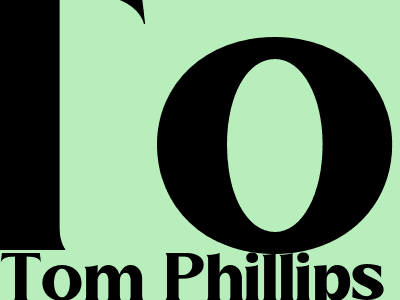Tom Phillips: An Artist's Journey
Early life and Influences:
Born in 1937 in Bristol, England, Tom Phillips is a distinguished artist widely recognized for his unique approach combining painting, drawing, and collage. Throughout his childhood, Phillips' fascination with literature and music shaped his artistic vision. Inspired by the works of William Blake and John Cage, he embraced the principles of chance and indeterminacy, which would become pivotal in his artistic practice.
Education and Career:
Phillips attended the Camberwell School of Art and the Royal College of Art, where he studied painting. In 1963, he played a pivotal role in establishing The Artists Placement Group, a pioneering initiative that sought to merge art and the real world. Phillips' commitment to exploration and collaboration has fueled his prolific career, spanning over six decades. He has produced a vast body of work, including paintings, prints, sculptures, artist books, and installations.
Artistic Style and Techniques:
Tom Phillips is renowned for his intricate and thought-provoking artworks. He often incorporates found objects, ephemera, and appropriated images into his compositions, creating unique juxtapositions and narratives. His distinct style, which he refers to as "assisted art," involves chance operations, such as dice rolling or the use of computer programs, to determine aspects of his compositions. Phillips' work invites viewers to engage in a playful exploration of meaning, challenging traditional notions of originality and authorship.
Collage and Assemblage:
Phillips masterfully utilizes collage and assemblage techniques to create layered and meaningful works that explore themes of memory, identity, and the passage of time. By combining fragments of text, photographs, and other materials, he creates visually striking and conceptually rich artworks that invite viewers to uncover hidden connections and narratives.
Painting and Drawing:
Alongside his collage works, Phillips is also a skilled painter and draftsman. His paintings often feature bold colors and biomorphic forms, influenced by his fascination with the natural world. Phillips' exploration of randomness and chance extends to his drawing practice, where he employs techniques such as blind contour drawing to challenge traditional notions of representation.
Artist Books:
Phillips has made significant contributions to the field of artist books, creating unique publications that combine text, image, and typography. His acclaimed "A Humument: A Treated Victorian Novel" (1970) is a prime example, where he meticulously altered and rearranged the text of an 1864 novel, creating a new and deeply personal narrative.
Awards and Recognition:
Tom Phillips' exceptional contributions to the art world have been widely recognized. He was elected a Royal Academician in 1988 and has received numerous prestigious awards, including the Golden Lion at the 1984 Venice Biennale and the Turner Prize in 1987. Phillips' work has been exhibited in major institutions worldwide, solidifying his position as one of the most influential and respected artists of our time.
Conclusion:
Tom Phillips' artistic journey is marked by experimentation, innovation, and a profound engagement with the creative process. Through his unique approach and diverse body of work, he has made significant contributions to the art world. Phillips' legacy lies in his ability to challenge conventions, explore the boundaries of art, and inspire generations of artists to embrace the unexpected.

Komentar